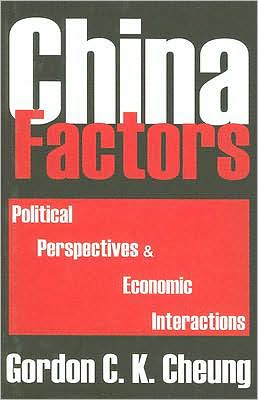

 |

|

The average rating for China Factors: Political Perspectives and Economic Interactions based on 2 reviews is 3.5 stars.
Review # 1 was written on 2016-05-16 00:00:00 Wesley Parker Wesley ParkerThis is a well researched book that challenges the contention of the free market and the "structure adjustment programs" as the only way towards secular growth in developing countries. This book shows how the import substitution, and the active investments from the state, led to secular growth, rising living standards and a place among the four Asian tiger economies. |
Review # 2 was written on 2017-12-13 00:00:00 Thomas Clary Thomas ClaryIn his book Locked in place, Vivek Chibber focuses on India's failure as a developmental state to promote an industrial economy despite the presence of apparent administrative and political leadership and commitment as well as a requisite industrial base. He further asks that why is it that even though it was apparent in the late 1950's and early 60's that the existing arrangements were not working, there was still no willingness to improve them. Reform instead came to mean "less intervention" by the state rather than "better intervention", so reform became about reducing the quantity of state intervention rather than improving the quality. Chibber delves into original and hitherto unused, archival materials and government documents to construct a narrative in opposition to the prevalent narrative which cites a lack of commitment on the part of the leaders and bureaucrats or the state as the reason behind this failure. He insists instead, that Indian businessmen and industrialists opposed the coordination of investment proposed by the state as well as the 'disciplinary planning' that the state felt was necessary. Under 'disciplinary planning', a combination of licenses and subsidies for those in line with the plan and withdrawal of these for those that were not would have given the state the ability to discipline firms. Even though the state was following the ISI strategy common to most developing countries in the 1940's and 50's, the state was not able to discipline the firms. So the firms enjoyed protection and profits from an uncompetitive domestic market, but this further meant that they did not need to innovate. The market was so largely protected that the firms did not need state support but went to considerable, and in most cases unethical lengths to get it. The Planning Commission was established with the intention of implementing "disciplinary planning", however in wake of capitalist opposition, it eventually lacked the capacity to discipline either the firms or the other governmental bodies and ministries. Other state-industry consultative commissions were also established but they remained ineffective as well. In Chibber's opinion therefore, the key to why India failed in creating a successful industrial economy lays not so much in the state but more in the relations between the state and the "capital". These relations of hostility, and of opposition are the analytical argument in this book. Chibber compares these conditions in India with the installation of the post-war developmental state in Korea. He argues that the success of the Korean model is in large part due to the alliance between the state and the Korean capitalist class and not due to the state domination of the capitalist class. The Korean state, seeing that its industrialization plans (driven partly by military imperatives) would require huge quantities of imports, needed Korean firms to export; and Korean firms wanted state support to make their entry into daunting export markets, including support conditional on them meeting rigorous quality standards in export markets. The Korean firms were therefore, much more cooperative than their Indian counterparts with arrangements in which they took on the role of implementers of government targets. They had an important role in setting of these targets, which gave them a means of disciplining government (to deliver on services) as much as the other way around. The driver of the difference between India and Korea in institutional arrangements of planning was thus the difference in development strategy ' ISI in India and ''export-led industrialization'' (ELI) in Korea. These two development strategies placed different incentives on the parties to state-capital interactions. ELI required intense state intervention, including to ''distort'' prices on a massive scale so as to accelerate investment along the lines determined not by the state on its own but by the consortium of state planners and organizations of firms. Therefore in Chibber's argument this is the main reason why Korea was able to set up a developmental state and India was not'this highlights state-capital relations in two different economies. Korean firms also had help from Japanese trading and manufacturing companies that were looking for cheaper labor options in the 1960's. Korea also received help from the US, which helped it in development planning and exports. India lacked almost all outside help however. Chibber largely underplays the differences between the two countries however. India's vast heterogeneity and differences in social background of the public officials and businessmen, is sharply different from Korea. Also India composed of many more states and is a federal setup, which would have imposed significant handicaps in terms of coordination. Overall, the book is an interesting read. |
CAN'T FIND WHAT YOU'RE LOOKING FOR? CLICK HERE!!!